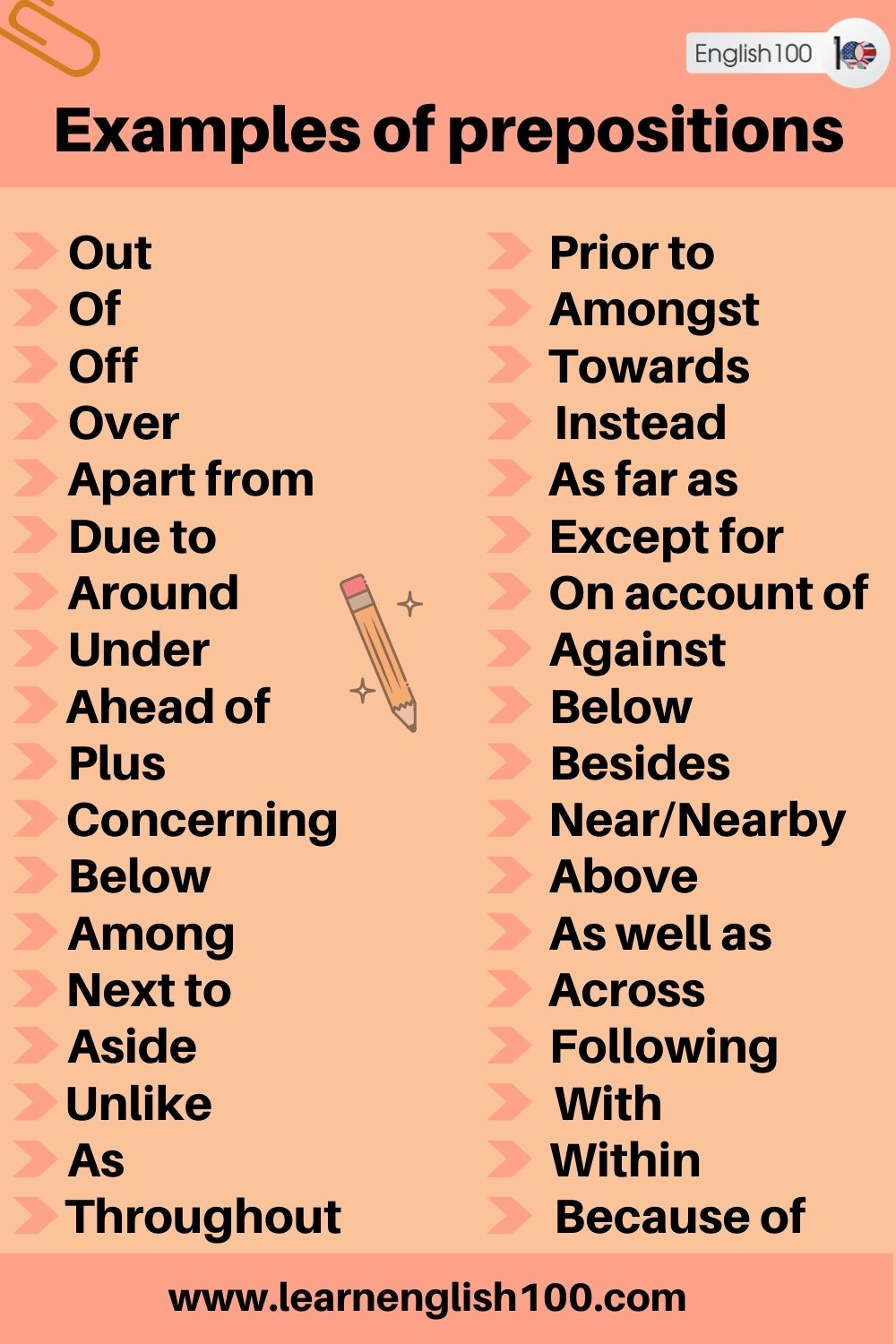Prepositions are fundamental elements of language that help us express relationships between objects, people, places, and ideas. These small but mighty words serve as bridges, guiding us through the intricacies of language. In this article, we’ll explore the world of prepositions and provide numerous examples to illustrate their versatility and importance in communication.
Defining Prepositions
Prepositions are words that typically show the relationship between a noun or pronoun (the object of the preposition) and other elements within a sentence. These relationships can involve time, place, direction, manner, or purpose. Prepositions act as connectors, helping us construct meaningful sentences. Common examples of prepositions include “in,” “on,” “at,” “above,” “below,” “between,” and “with.”
There is always a piece that holds everything together, sometimes it is called the piece of resistance, due to its key role in maintaining or revolutionizing the place where it lies. Prepositions play that role in each sentence despite being functional and lacking the ability to deliver meaning on their own. Without their unique ability to connect and bond the sentences, there would be no meaning possible.
Uses of Prepositions
Prepositions serve several important functions in English:
Indicating Location or Direction: Prepositions such as “in,” “on,” “at,” “by,” and “to” are used to specify location or direction. For example: “The book is on the table,” “She lives in New York,” “We’re going to the park.”
Expressing Time: Prepositions like “in,” “on,” “at,” and “since” are used to indicate time. For instance: “The meeting is at 9 o’clock,” “I’ll see you on Monday,” “He has been working here since 2010.”
Showing Relationships: Prepositions help show relationships between elements in a sentence. For example: “She is married to him,” “The cat is under the table,” “They walked along the river.”
Linking Phrases in a Sentence: Prepositions connect phrases or clauses within a sentence. For instance: “Despite the rain, we went for a walk,” “I’ll meet you at the restaurant or in the park.”
Indicating Means or Method: Prepositions such as “with,” “by,” and “through” can indicate the means or method by which something is done. For example: “She cut the cake with a knife,” “He solved the problem by thinking carefully.”
Expressing Purpose: Prepositions like “for” and “to” can express purpose or intention. For instance: “I’m going to the store for some groceries,” “She bought a gift for her friend.”
Showing Possession: Prepositions such as “of,” “for,” and “with” can indicate possession or ownership. For example: “The keys are on the table,” “This book is for you.”
Types of Prepositions
Prepositions can be categorized into several types based on their functions and usage:
| Simple Prepositions | Compound Prepositions | Time Prepositions | Place Prepositions | Direction Prepositions | Agentive Prepositions | Instrumental Prepositions | Temporal Prepositions |
|---|---|---|---|---|---|---|---|
| in | because of | in | in | to | by | by | during |
| on | instead of | on | on | from | with | with | for |
| at | out of | at | at | into | through | using | since |
| by | according to | during | by | out of | from | via | from |
| for | by means of | since | behind | through | via | through | to |
| to | in front of | for | beside | across | on | by means of | until |
| from | on behalf of | from | between | along | upon | etc. | before |
| with | in spite of | to | among | up | etc. | after | |
| over | until | under | down | at | |||
| under | before | over | over | on | |||
| among | after | above | under | by | |||
| between | etc. | below | around | within | |||
| etc. | inside | past | etc. |
Examples of preposition in sentences
Here are some examples of prepositions:
- Despite being in debt, she still has enough money for a vacation in Australia.
- He lost a lot of money while gambling, so he is in a serious pickle.
- Many actors and actresses have said the wrong thing on the air.
- For his own health, the doctor advised William to go on a diet.
- Elon Musk kept going after his dreams until he achieved them.
- If you keep talking about your defeat, this will be everything you can see.
- Upon graduating, Fillip decided to find a job in the countryside.
- The accident was caused by a reckless driver.
- The jogger is running at a high speed.
- Mary saw her lover at a distance and ran into his arms.
- Sometimes, things go beyond our reach.
- Always, what is on the inside will find its way to the outside.
- Richard lives in a house by the lake and every morning there are birds chirping outside of his window.
- The thief tried to escape the police by jumping over the ledge.
- My friend Tom is immaculate. Hence, I ask him to proofread my work before I hand it in.
- Timothy has gone below the deck of the ship to fix an issue with the engine.
- Besides my problem, there has been an explosion near my house.
- Carla promised to keep this secret between me and her.
- The spy lives across the street from his victim, so move in at his house carefully.
- There is an annoying neighbor who lives above my apartment.
- Love does not exist without trust.
- Life without faith is worthless.
- Friendship when combined with emotions is love.
- True friends come through in difficult times.
- No one can find a purpose for himself but himself.
Importance of prepositions
Prepositions play a crucial role in language and communication. Here’s why prepositions are important:
Establishing Relationships: Prepositions help establish relationships between different elements in a sentence. They clarify the spatial, temporal, and logical connections between nouns, pronouns, and other words.
Adding Specificity: Prepositions add specificity and detail to sentences by providing information about location, time, direction, manner, and more. They help paint a clearer picture and convey precise meanings.
Common issues involving prepositions with examples
Issue 1: Capitalization in Titles
- Incorrect: “The Journey through The Forest”
- Correct: “The Journey through the Forest”
Issue 2: Wrong Case after Preposition
- Incorrect: “The gift is for he.”
- Correct: “The gift is for him.”
Issue 3: Confusing Prepositions with Other Words
- Incorrect: “I’m going to run to the store.”
- Correct: “I’m going to run at the store.”
Issue 4: Ending a Sentence with a Preposition
- Incorrect: “Where is he going to?”
- Correct: “Where is he going?”
Issue 5: Keeping Writing Succinct
- Incorrect: “The purpose of this research study is to analyze the effects of caffeine on the cognitive performance of college students.”
- Correct: “This research analyzes the effects of caffeine on college students’ cognitive performance.” By being aware of these issues and using prepositions correctly, you can enhance the clarity and effectiveness of your writing. Proper use of prepositions ensures accurate communication and helps convey your intended meaning with precision.
FAQ about examples of preposition
What are 10 examples of preposition?
Here are 10 examples of sentences using prepositions:
1. Location/Place: The cat is under the table.
2. Time: They will meet at the park at 3 PM.
3. Direction: She walked toward the door.
4. Manner: He solved the problem with ease.
5. Purpose: She went to the library for research.
6. Relationships: The book is between the two bookends.
7. Possession: The keys are in my bag.
8. Comparison: She is like her sister.
9. Cause and Effect: The plant grew quickly because of the sunlight.
10. Amount/Measure: He ran over five miles.
What are 15 examples of prepositions?
Here are 15 examples of prepositions used in sentences:
- The cat is on the roof.
- She’ll arrive at the airport around noon.
- He walked through the forest.
- She smiled with joy.
- He bought a gift for his sister’s birthday.
- The keys are under the pillow.
- The book is between the two bookshelves.
- They met by the river.
- The flowers are in the vase.
- He is sitting beside me.
- They traveled across the country.
- She ran after the bus.
- The painting is like a masterpiece.
- The meeting is scheduled for Monday.
- The cake is for the party.
These sentences illustrate how prepositions are used to indicate relationships, locations, times, and various other aspects within sentences. Prepositions are essential for providing context and clarity in language.
What are some commonly Confused Prepositions?
There are several pairs or groups of prepositions in English that are commonly confused due to their similar meanings or usage. Here are some examples:
In vs. Into:
“In” indicates location within something, while “into” indicates movement or direction toward the inside of something.
Example: “She is in the house” (location), “She walked into the house” (movement).
On vs. Upon:
Both can indicate location or contact with a surface, but “upon” is more formal and often implies a sense of elevation or emphasis.
Example: “The book is on the table” (location), “He placed the crown upon her head” (formal, emphasis).
At vs. In vs. On:
These prepositions are often confused when indicating location, especially in relation to buildings or places.
“At” is used for specific points or locations, “in” is used for enclosed spaces, and “on” is used for surfaces or areas.
Example: “I am at the library” (specific point), “I am in the library” (inside the building), “I am on the library’s roof” (surface).
Between vs. Among:
“Between” is used when referring to two distinct entities or individuals, while “among” is used for more than two.
Example: “The book is between Mary and John” (two individuals), “The book is among the students” (more than two).
Among vs. Amid:
Both indicate being surrounded by or in the midst of something, but “among” is more common in general usage, while “amid” is more formal or literary.
Example: “She found herself among friends” (common usage), “He remained calm amid the chaos” (formal, emphasis).
To vs. For:
“To” is often used to indicate movement, direction, or purpose, while “for” is used to indicate benefit, purpose, or intended recipient.
Example: “She went to the store” (movement), “She bought flowers for her mother” (benefit/recipient).
On vs. Upon:
While both can indicate contact with a surface, “upon” is more formal and often carries a sense of elevation or emphasis.
Example: “The keys are on the table” (location), “He placed the keys upon the table” (formal, emphasis).
To conclude, prepositions are essential building blocks of language that facilitate clear and precise communication. They enable us to convey relationships, locations, times, and much more in our sentences. Understanding how prepositions work and using them effectively enhances our ability to express ideas and share information with others. As you continue to explore the rich tapestry of language, remember the invaluable role that prepositions play in guiding your words and thoughts.

